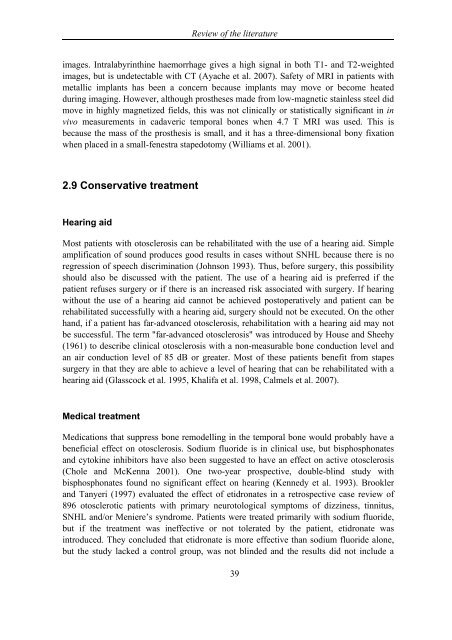Modern surgical treatment of otosclerosis - Helda - Helsinki.fi
Modern surgical treatment of otosclerosis - Helda - Helsinki.fi
Modern surgical treatment of otosclerosis - Helda - Helsinki.fi
You also want an ePaper? Increase the reach of your titles
YUMPU automatically turns print PDFs into web optimized ePapers that Google loves.
Review <strong>of</strong> the literature<br />
images. Intralabyrinthine haemorrhage gives a high signal in both T1- and T2-weighted<br />
images, but is undetectable with CT (Ayache et al. 2007). Safety <strong>of</strong> MRI in patients with<br />
metallic implants has been a concern because implants may move or become heated<br />
during imaging. However, although prostheses made from low-magnetic stainless steel did<br />
move in highly magnetized <strong>fi</strong>elds, this was not clinically or statistically signi<strong>fi</strong>cant in in<br />
vivo measurements in cadaveric temporal bones when 4.7 T MRI was used. This is<br />
because the mass <strong>of</strong> the prosthesis is small, and it has a three-dimensional bony <strong>fi</strong>xation<br />
when placed in a small-fenestra stapedotomy (Williams et al. 2001).<br />
2.9 Conservative <strong>treatment</strong><br />
Hearing aid<br />
Most patients with <strong>otosclerosis</strong> can be rehabilitated with the use <strong>of</strong> a hearing aid. Simple<br />
ampli<strong>fi</strong>cation <strong>of</strong> sound produces good results in cases without SNHL because there is no<br />
regression <strong>of</strong> speech discrimination (Johnson 1993). Thus, before surgery, this possibility<br />
should also be discussed with the patient. The use <strong>of</strong> a hearing aid is preferred if the<br />
patient refuses surgery or if there is an increased risk associated with surgery. If hearing<br />
without the use <strong>of</strong> a hearing aid cannot be achieved postoperatively and patient can be<br />
rehabilitated successfully with a hearing aid, surgery should not be executed. On the other<br />
hand, if a patient has far-advanced <strong>otosclerosis</strong>, rehabilitation with a hearing aid may not<br />
be successful. The term "far-advanced <strong>otosclerosis</strong>" was introduced by House and Sheehy<br />
(1961) to describe clinical <strong>otosclerosis</strong> with a non-measurable bone conduction level and<br />
an air conduction level <strong>of</strong> 85 dB or greater. Most <strong>of</strong> these patients bene<strong>fi</strong>t from stapes<br />
surgery in that they are able to achieve a level <strong>of</strong> hearing that can be rehabilitated with a<br />
hearing aid (Glasscock et al. 1995, Khalifa et al. 1998, Calmels et al. 2007).<br />
Medical <strong>treatment</strong><br />
Medications that suppress bone remodelling in the temporal bone would probably have a<br />
bene<strong>fi</strong>cial effect on <strong>otosclerosis</strong>. Sodium fluoride is in clinical use, but bisphosphonates<br />
and cytokine inhibitors have also been suggested to have an effect on active <strong>otosclerosis</strong><br />
(Chole and McKenna 2001). One two-year prospective, double-blind study with<br />
bisphosphonates found no signi<strong>fi</strong>cant effect on hearing (Kennedy et al. 1993). Brookler<br />
and Tanyeri (1997) evaluated the effect <strong>of</strong> etidronates in a retrospective case review <strong>of</strong><br />
896 otosclerotic patients with primary neurotological symptoms <strong>of</strong> dizziness, tinnitus,<br />
SNHL and/or Meniere’s syndrome. Patients were treated primarily with sodium fluoride,<br />
but if the <strong>treatment</strong> was ineffective or not tolerated by the patient, etidronate was<br />
introduced. They concluded that etidronate is more effective than sodium fluoride alone,<br />
but the study lacked a control group, was not blinded and the results did not include a<br />
39

















